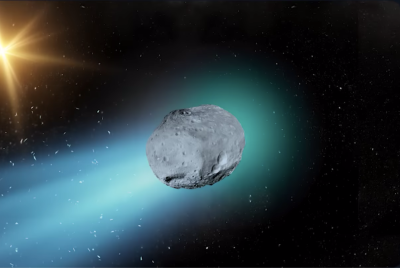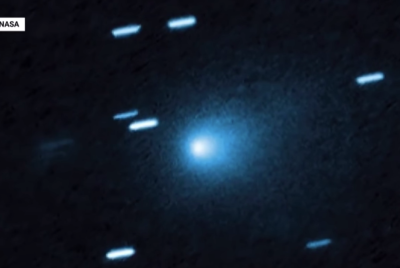Breakthrough Radio Signal from Comet 3I/Atlas Silences Sceptics and Reveals Its True Identity
OH absorption lines recorded by MeerKAT, and ultraviolet OH seen by NASA's Swift, together show 3I/ATLAS is actively outgassing — and not broadcasting an artificial signal.

A decisive radio detection from the MeerKAT array has effectively ended the urgent question of whether interstellar visitor 3I/ATLAS is a natural comet or something stranger.
For weeks, the object dubbed 3I/ATLAS has inspired fevered online debate and high-profile speculation that it might be an engineered artefact. That conversation shifted dramatically after South Africa's MeerKAT radio telescope recorded hydroxyl (OH) absorption lines, the radio fingerprint of water-related chemistry, from the object on 24 October 2025.
NASA' Swift Observatory corroborated the finding and detailed in rapid scientific notices, provides direct evidence that 3I/ATLAS is actively outgassing volatile material, a behaviour consistent with a comet rather than a technological beacon.
MeerKAT's Radio Breakthrough
MeerKAT's 64-dish array in the Karoo detected absorption notches at the canonical OH radio lines of 1,665 and 1,667 MHz, a spectral signature astronomers expect when sunlight vaporises icy material and hydroxyl radicals absorb background radio emission.
The observation, made when 3I/ATLAS lay only a few degrees from the Sun in the sky and therefore difficult to observe optically, represents the first confirmed radio spectrum of an interstellar object.
Astronomers using the South African radio telescope array MeerKAT have detected a clear radio-frequency signal from the interstellar object 3I/ATLAS, bringing strong support to the idea that it is a natural comet rather than an artificial object.
— Erika (@ExploreCosmos_) November 10, 2025
The signal consists of… pic.twitter.com/gD5OSoAIIi
The Astronomer's Telegram posting that announced the result lists the observing team and gives measured Doppler shifts and line widths consistent with outflowing, thermally broadened OH gas. Those precise numbers, published by DJ Pisano and collaborators, enabled teams worldwide to tie the radio features to the comet's known trajectory and velocity, strengthening the interpretation that the signal arises from natural coma chemistry rather than an artificial transmitter.
Ultraviolet Confirmation: Water, Not Wireless
Independent ultraviolet imaging with NASA's Neil Gehrels Swift Observatory had already reported OH emission in July–August 2025, a firm ultraviolet fingerprint of water activity at unexpectedly large distances from the Sun. The Swift team, led by researchers at Auburn University, derived water-production rates of the order of tens of kilograms per second, a level of activity that helps explain the robust OH signal MeerKAT later detected in the radio band. Those peer-reviewed results appear on the arXiv preprint server and were summarised in The Astrophysical Journal Letters.
'Every interstellar comet so far has been a surprise,' said Zexi Xing, a co-author on the Swift study, capturing the human drama of a discovery that forces scientists to rethink how volatile materials survive and evolve in objects formed around other stars.
The ultraviolet and radio measurements together offer a coherent, multi-wavelength portrait: 3I/ATLAS is shedding water-related molecules, producing both the faint UV glow of OH and the characteristic radio absorption lines.
What It Means For Science And The Public
Practically, the MeerKAT result gives researchers a rare opportunity to compare an interstellar object's volatile inventory with comets formed in the Solar System. Swift's UV work suggested unusually high water loss at large heliocentric distances, and the radio detection now lets chemists and dynamicists quantify those losses with spectral precision. This improves models of how planetary systems form and how material is ejected into interstellar space.
For the public, the episode is revealing: it demonstrates how multi-wavelength astronomy, optical, ultraviolet, and radio, resolves ambiguous claims, and how rapid, transparent publication (via arXiv, The Astronomer's Telegram, and observatory notices) allows the global community to verify and interpret surprising results in real time.
'Detecting OH in multiple regimes is exactly the smoking gun we needed,' one astronomer told colleagues in the immediate aftermath, a reminder that science advances by accumulating convergent evidence rather than viral conjecture.
3I/ATLAS remains a compelling scientific prize: as it continues on its one-way journey through the Solar System, coordinated observations from ground and space will further refine its composition and structure, and may yet reveal more unexpected lessons about the materials that form around distant stars.
The radio and ultraviolet fingerprints make a persuasive case: 3I/ATLAS behaves like a wet, active comet from another star, and that conclusion now rests on the best available multi-wavelength evidence.
© Copyright IBTimes 2025. All rights reserved.




















